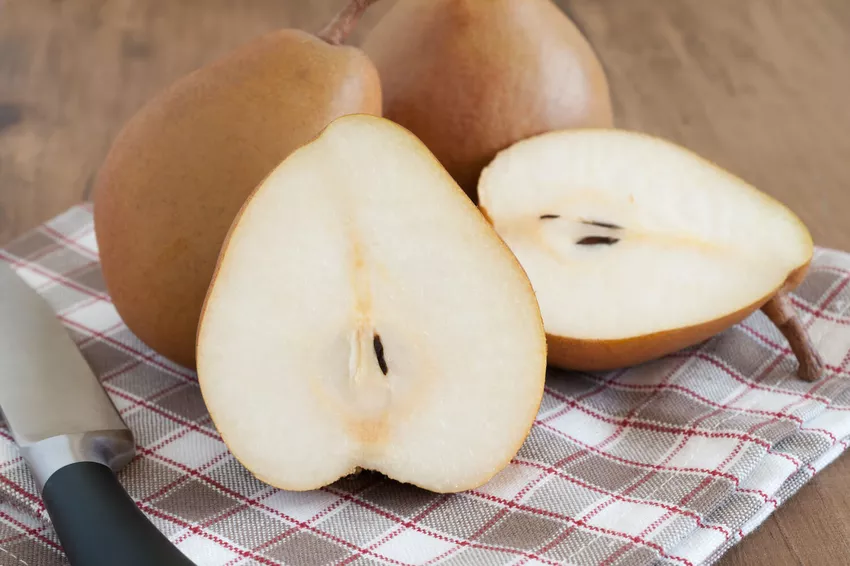'Gellerts Butterbirne' is a historic pear variety from France that is still very popular today. The butter pear is a robust variety with tenderly melting, aromatic fruits.

Are you looking for a strong pear tree for your garden? Then you've come to the right place with the 'Gellert's Butter Pear' variety. We will show you how to cultivate the pear variety correctly and what special features characterize the fruit.
'Gellert's Butter Pear': Profile
| Synonyms | 'Gellerts', 'Beurré Hardy' |
| Fruit | medium to large; greenish-ochre ground colour, orange-brown on the sunny side; even rusting |
| Flavour | juicy, refreshing, fine acidity |
| Yield | rather regular |
| Harvest time | from the beginning of September |
| Maturity for pleasure | Mid September to late October |
| Shelf Life | bad; can be stored until the end of October |
| Growth | very strong |
| Climate | undemanding; windy and too dry locations are not well tolerated |
| Diseases and Pests | susceptible to scab, viral stone fruit and fruit tree canker |
History and origin of the pear variety
The cultivated pear Pyrus communis ˈGellerts butter pearˈ is an old pear variety that is very popular. The variety was first cultivated in France around 1820 by M. Bonnet. It soon came onto the market under the name ˈBeurré Hardyˈ. That is why 'Gellert's butter pear' is sometimes still traded under the name 'Beurré Hardy'. Only when it was launched in Germany was the variety given the name ˈGellerts Butterbirneˈ or just ˈGellertsˈ.
Characteristics and taste of ‘Gellert’s Butter Pear’
The fruits of the butter pear are medium-sized to large table pears with a truncated cone shape. The outer appearance is characterized by fine russeting, which usually covers the entire fruit. The shell is rathercoarse and rough, which can interfere with consumption. The basic color of the pears is greenish-ochre. On the sunny side, the fruits form an orange-brown colour. The flesh is yellowish-white, very juicy and refreshing with a fine acidity - it's not for nothing that 'Gellert's butter pear' is considered one of the best table pears.

Gellert's Butter Pear Growing & Care Tips
The 'Gellerts Butterbirne' variety shows very strong growth. This trait can be somewhat moderated with a slower rootstock. Nevertheless, the variety is less suitable for trellis cultivation, but rather good for standard trees in a spacious garden or on an orchard. The tree attains a height of well over 5 meters on its own roots or on seedlings and forms an upright, later laterally overhanging crown.
'Gellert's Butter Pear', however, can be grafted well on quince rootstocks, resulting in greatly reduced growth and an increased yield per tree. In this way, the pear can also move into smaller gardens. Suitable quince rootstocks are 'Quitte C', 'Quitte Sydow' and 'Quitte A'. But reduced growth can also be achieved with weak-growing pear rootstocks: the rootstock 'Pyrodwarf' deserves a special mention.
Tip: The respective rootstocks also have an effect on the properties of the variety: on quince rootstocks, for example, the ′Gellerts′ is more susceptible to frost and lime.
'Gellert's Butter Pear' is widely described as a hardy cultivar to disease, especially wood frost. She is also undemanding about her location. It does not tolerate windy locations and soil that is too shallow or too dry.
The flowering of 'Gellert's Butter Pear' is early to mid-early, but quite tolerant of late frosts. For this reason, the yields do not fluctuate greatly from year to year - unless a poor location provokes this. Plenty of pollen is produced, which benefits bees and other pear trees nearby. Good pollinators for 'Gellerts Butterbirne' are, for example, 'Bosc's Flaschenbirne', 'Clapps Liebling', 'Gute Luise' and 'Delicious from Charneux'.
Due to its very strong growth, it is important that 'Gellert's Butter Pear' is pruned annually and only sparingly. A radical pruning provokes strong growth, reduces yields and ensures fluctuating harvests in the coming years ( alternance). Especially on weak onesHowever, on rootstocks and on old, senile trees, the tautly upright growing pear may lack branching and fruiting wood, so branching should be stimulated by a slightly heavier pruning. 'Gellert's Butter Pear' is susceptible to scab, viral stone fruit and fruit tree canker.
Pear variety 'Gellert's butter pear' harvest and use
The delicious fruits of 'Gellert's Butter Pear' can be harvested from early to mid-September when they are still firm. They are then ready to eat after one to two weeks, because only pears of this variety that have ripened show their full aroma. All pears should be eaten or processed by the end of October, because unfortunately 'Gellert's Butter Pear' cannot be stored for long.
In order to extend the storage time of the pears, it is possible to harvest them earlier, i.e. as early as the end of August. They stay fresh longer, but have a worse taste. The 'Gellerts' can also be used very well for baking or preserving.
One of the most commonly grown pear varieties in Germany is the 'Alexander Lucas' pear. Read the special article to learn more about this old variety that offers excellent fruit.